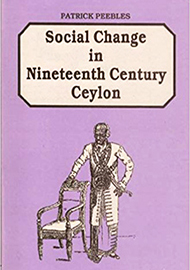Patrick Peebles
 This book by Peebles examines the social and economic changes spanning the nineteenth century with special emphasis on the Singhalese Elite (the Mudaliyar class) and how caste, kinship, service tenures and land control interacted with their duties as colonial administrators.
This book by Peebles examines the social and economic changes spanning the nineteenth century with special emphasis on the Singhalese Elite (the Mudaliyar class) and how caste, kinship, service tenures and land control interacted with their duties as colonial administrators.
Page 45: With reference to caste hierarchy.
It is impossible to derive a unitary Singhalese caste hierarchy; although in the nineteenth century the India-oriented British strove mightily to do so.
The absence of a rigid hierarchy is confirmed by the diary of Adrian de Alwis. He records for example that the goyigama Maha Mudaliar Nicholas Dias Abeysinghe named karava Mudaliyar of the Fishers, Reynoldus de Andrado, an executor of his estate.
Page 73: With reference to the issue of gold medals as symbols of government patronage, by British Governors North(7), Maitland(1), Brownrigg(11) and Barnes(9).
Of these 28 medals, the great majority were awarded to the leading goyigama mudaliyars of the Western Province. One was awarded to a Tamil, one to a Kandyan Singhalese, and only four to non-goyigama Cornelis and Johannes de Fonseka (both Karava ), George Nadoris de Silva (salagama ) and Mathew Gomes (rajaka ). Solomon Dias Bandaranaike received two.
Page 140: Reference the banquet held on August 3, 1858, to celebrate the cutting of the first sod on the Ceylon Railways, the protocol of table arrangement and the British calculation of the status hierarchy.
There were 16 tables; the Governors table and fifteen lettered tables from A to P. Table M was the most heterogeneous. In addition to goyigama mudaliyars there were five karava, the brothers Jeronis and Susew de Soysa, Manuel de Fonseka, mudaliar of Panadura and Kalutara; Joseph Mendis, the Mudaliyar of Alut Kuru Korale and Negambo; and Lindamulage John de Silva. The choice here is interesting. De Fonseka and Mendis were of old established elite families, but were chosen because they were in the mudaliyar administrative hierarchy. This is clear because the two karava mudaliyars of Colombo, Andrew and Pedro Fernando, did not attend. By family status and even mudaliyar rank the Fernando brothers would have been expected to attend, but the British seem to be determined to play down the role of the cast headmen.
The arrangement displays a careful calculation of the status hierarchy. The arrangement shows first of all the superiority of the British, the relative superiority of the Burghers and the predominance of the first-class goyigama. It does not make a statement endorsing the caste hierarchy, because other than the pelantiya of the Dias family, the goyigamas are interspersed with the lesser breeds.
Page 165: With reference to karava marriages.
Whereas the first class goyigama resisted the emergence of entrepreneurial groups (“nobodies” as opposed to “somebodies”, in S. C. Obeysekere’s terms), the high-status families among karava began to marry into the new elite.
Examples can be taken from the marriages of three mudaliyar families (de Fonsekas of Kalutara, Mendis Jayawardenes of Moratuwa, and Fernandos of Colombo) with the de Soysa and Pieris families. Louis Pieris, the younger brother of Jeronis Pieris, married a daughter of Carolis de Fonseka. Richard Steuart Pieris married a daughter of proctor S. R. de Fonseka of a different branch of the family. Gate Muhandiram Johannes Mendis Jayawardene married a daughter of Haramanis Soysa. His son married a daughter of Louis Pieris, and his daughter married a son of Jeronis Pieris.
The result of such marriages were to create a single Karava elite incorporating wealth and status.
Page 233: With reference to the appointment of Mudaliyars, post 1833.
In 1833, lord Goderich included the policy of opening the higher ranks of mudaliyars to non govigama with the reorganization of the Native Department, required by the abolition of Rajakariya and the Cinnamon Department. The first non-goyigama mudaliyars after 1833 appear to have been Joseph Mendis, Mudaliyar of Chilaw in 1844 and Mudaliyar of Alut Kuru Korale North in 1846, and T. M. Wickremenayake, Mudaliyar in Galle District in the Southern Province in 1844.
Manuel de Fonseka, son of Johannes de Fonseka, was appointed “Mahavidana Mudaliyar” of Kalutara and Panadura Totamunes in 1837. This gave him the duties of a mudaliyar in the most populous mudaliyar district, without the appropriate rank. He was not given the unqualified title of mudaliyar until 1853.